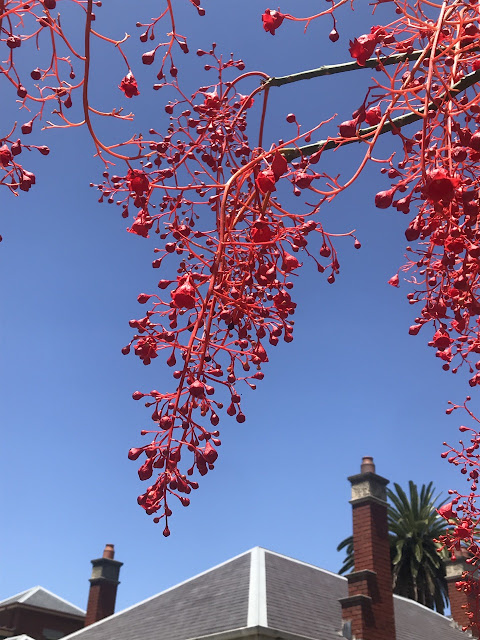In November 2021 we had the beams replaced in the conservatory because they had started to rot. During the process all the plants and the ornamental pond had to be removed. In the course of the project I decided to reduce the number of plants and replace the pond with a smaller water feature.
This night-time photo shows the much reduced number of plants that I returned to the conservatory in November last year.
Most of the plants have done well since then. The best performer so far has been this "Brazillian Jasmine", which I think is a cultivar of Mandevilla sanderi, (and is not fragrant).
Yesterday was New Year's Eve and we were blessed with a visit from Spike, the echidna, who had also been in the garden earlier in the week. The warm weather suits Spike, who was feeding on little insects that enjoy the damp soil around the Rosa "Mr Lincoln" that I have been watering lately.
Not needing so much water is the Scabiosa atropurpurea. I am pleased to have noted two Scabiosa plants elsewhere in the garden with white flowers and intend to try to gather some of the seed.
Sally Wilkinson's very pale pink Hydrangea is flourishing this year, as are the other Hydrangeas. I decided it would make a good subject for a small ikebana re-using pine from my Christmas ikebana. I did not have the opportunity to make a larger New Year's ikebana and instead made two smaller ones.
For the first ikebana I set the materials in an egg-shaped vessel that I bought in Seto City in about 2004. The clay is unglazed but splashed with a few small lines of creamy-white glaze.
I also re-used the remaining branch of pine for the second ikebana, to which I added a bud and fully opened Mr Lincoln rose. The Irregularly-shaped small vase, from Mashiko, is made from a dense dark clay and has an ash glaze around the mouth.
On Christmas Day I made a welcoming ikebana, Omukaebana, for our small family celebration. For that, I also re-used materials. The corky elm was from a class at Elizabeth's place at the end of October. I added a single cerise Hydrangea as a mass and contrasting colour focal point.
I hope this finds you well and wish you all the best for 2023.
Christopher
1st January 2023



































